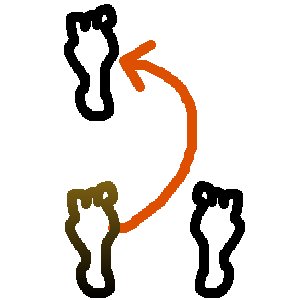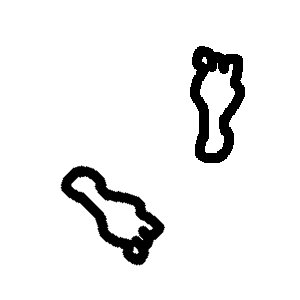| Seisan
Kata for Dummies
|
||||
| Main
|
Page1 - Page 2 - Page 3 - Page 4 First off, Take a bow and while standing straight, place your right open hand over your fisted left hand in front of your waist (or belt if you are wearing one). This shows respect to whom it may concern. Now go into a Ready Stance. This stance says "I'm ready to bust out with my Kata, so look out!", so it's needed. A ready stance is easy: move your feet about a foot apart, slightly bend your knees, and move both arms to your sides and bend them so your fists are at your waist. Please don't grunt while you're at it, that's just silly. Now you're ready for some simulated action. Move forward with your left foot, performing a crescent step, ending in a Seisan stance. At the same time as you are moving forward, stack both fists on your right side at the waist, left fist over the right fist, and as you end the crescent step and go into the seisan stance, perform a left-hand side block. From the left-hand side block, perform a right-hand reverse punch. If you're new to all this, there's a few of things that might be going through your head: "What is a 'crescent step'?" "What is a 'Seisan stance'?" "What is a 'stack'?" "What is a 'side block'?" "What is a 'reverse punch'?" "What is the airspeed velocity of an unladen swallow?" All very fair questions, except the last
one, which makes no sense to ask in this context. We'll answer the
sensible questions now: A crescent step is simply stepping forward with one foot, but not straight forward as you normally would, but in a sort of arc, like so:
Yes those are suppose to be feet. *You* try drawing the blasted things in Paint Shop. A Seisan stance simply looks like the two completely black feet you see above, with one foot in front of the other. Note that a good Seisan stance has both feet pointing straight forward. Not like this:
Nor this: : Nor this:
Though admittedly the latter stance is somewhat impressive if you can pull it off. What is a stack? Stacking your hands simply means putting both fists on the same side at the waist. If you're stacking on the right, the right fist is at the waist, and your left fist reaches over in a friendly sort of way, and sets itself neatly on the left fist. Vice versa if you're stacking on the left. You will notice that when your hands are in this position, it sort of looks like you're about to draw a sword from your side, except when you are drawing a sword, the thumb of the opposite fist is oriented downwards, whereas when you're stacking, that thumb is oriented upwards. In both cases, the thumb of the fist below the opposing fist is oriented upwards.
Oh heck, it looks like this:
What is a side block? A side block is when the forearm swings up from the stacking position and stops with the arm bent and the fist horizontally level with the shoulder. Note that only the arm whose fist is on top in the stacking position swings up. The fist at the bottom of the stack stays right there. So when performing a sideblock, the fist that isn't sideblocking stays stacked. What is a reverse punch? A reverse punch is not, as the name might lead some to believe, a punch that goes backwards. Rather, it is a punch performed with the hand opposing the foot that is forward in the seisan stance. Meaning, if you're in a left-foot forward seisan stance, a reverse punch is performed with the right hand, and vice versa. The Isshin-ryu punch is not aimed at the chest, as is commonly seen in other fighting arts. It is aimed at the solar plexis (which is the middle point just below the chest), and is performed so that the arm is only 80-90% extended before it is retracted. There are no extended joints in Ishin-ryu, as, theoretically, extended joints present an easy target for an assailant who knows what he or she is doing. The fist of the Ishin-ryu punch is also unique. It is a vertical fist, with the thumb locked at the side of the knuckle of the forefinger. If you were on the receiving end of such a punch, it'd look like this:
Now that we know what each individual move looks like, from the ready stance, step forward with a crescent step into a left-foot-forward seisan stance, and perform a left-hand sideblock. Then, perform a right-hand reverse punch, making sure to stack the left hand at the waist while punching with the right. Then, step forward again with your right foot into a right-foot-forward seisan stance and perform a left-hand reverse punch. Again, make sure you're stacking the right hand at the waist. Then step forward again with your left foot into a left-foot-forward seisan stance and do another right-hand reverse punch. Simply put, do the same thing three times, alternating between left and right. Now you should be in a left-foot-forward seisan stance. The next move is to shuffle forward while performing a sort of double-fisted strike. The shuffling forward is pretty simple: just lift your front foot a little and push off with your back foot so you skip ahead a few inches, making sure you stop in a proper seisan stance. You're still in the left-foot-forward seisan stance when you end, so both feet remain pretty much in the same position relative to each other the whole time. This is what I mean:
The double-fisted strike is a little more complicated to explain, and there's as many variations on how people do as there are ways to explain it. Since I have no definitive knowledge of how it's done, I'll just roughly describe the different phases of this move, and one may be free to extrapolate between them. 1) Your forearms are horizontal in front of you at chest level, and both fists are pointing towards each other. It's sort of like what you'd do if you were imitating a chicken, except you don't flap your arms and your fists are almost touching each other. 2) You do a double sideblock, except your fists wind up a little closer together than shoulder length, so it's not really a double sideblock. We'll call it the narrow-double-sideblock. 3) From the narrow-double-sideblock, strike up and forward with both fists, as though you were trying to brain someone from the chin up. 4) Bring your fists back into the narrow-double-sideblock position after the aforementioned braining. When you're done with the shuffle/braining move, you ought to still be in a left-foot-forward seisan stance. While you're still in that stance, open your fists so that your fingers are straight and held together and the thumb is tucked in at the side of the palm. Now cross your open hands at the wrist right in front of your chest. The right wrist should be behind the left. The palms shouldn't be facing you; the right palm should face your left side and the left palm should face the right side. From this position, strike up and forward with both hands in that crossed formation, as though you were striking someone in the neck (or, again, as though you were braining someone from the chin up, if you prefer that description). Don't bring your hands back to your chest when you're done: leave your arms extended. This concludes the first part of the kata.
|
Seisan Kata for Dummies |






